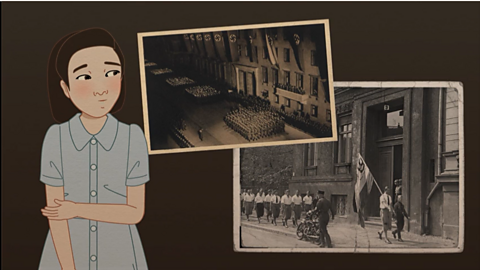Key points
Adolf Hitler served in the German army in World War One, and in 1919 joined the German Workers’ Party. This would go on to become the Nazi Party.
After a failed attempt to take over Germany in 1923, the Nazi Party took advantage of the impact of the Great Depression in 1929 to win public support.
Hitler was appointed German Chancellor in January 1933.
Antisemitism
antisemitismHostility or prejudice towards Jewish people. did not emerge for the first time when Hitler and the Nazis took power in Germany in 1933. Prejudice and hostility towards Jewish people had existed for centuries throughout Europe and beyond. This frequently led to violence against Jewish communities, and to laws that discriminationTreating people differently on the basis of a particular characteristic, such as race, religion or sex. against Jewish people. Across many different countries, Jews were stopped from doing particular jobs, or forced to live in specific areas. Jewish people were also sometimes made to wear badges or items of clothing to show that they were Jewish.
Throughout history, Jewish communities were forced to leave their countries, and had to find a new place to live. Lies were also spread about Jewish people, and they were wrongly blamed for disasters such as plagues.
Some of these laws and discriminatory practices against Jewish people began to be lifted over time, and Jewish communities came into more and more contact with their non-Jewish neighbours. Jewish communities made big contributions to the cultures of their countries. In Germany in 1933, Jewish people were largely assimilationTo be fully integrated into a system or society. In 1933, Jewish people were mostly an accepted and welcome group in German society. into German society. However, prejudice and hatred towards Jews remained, with many people continuing to hold antisemitic beliefs.
When Hitler came to power in 1933, he acted on this antisemitic prejudice, which had existed for a very long time, and underpinned his ideas.
To find out more about Jewish life in pre-war Europe, read this guide.
Hitler up to 1914
Adolf Hitler was born in Braunau, Austria, in 1889. Growing up, he aspired to be an artist. He applied to Art College in Vienna on two occasions, but was unsuccessful. Struggling to make a living, he lived in a shelter for homeless men in Vienna and earned money by painting portraits.
Hitler moved to Munich in 1913 and joined the German army when war broke out in 1914.
World War One
During World War One, Hitler was wounded twice and awarded several medals. In October 1918, he was temporarily blinded by mustard gas. While he was in hospital, he heard that Germany had surrendered. Hitler claimed that he cried upon hearing this news. He was angry, feeling that the German army had been betrayed by their government.
At the end of World War One, Hitler and others in Germany, who were seeking a scapegoatA person or group of people who is unfairly blamed for the mistakes or failures of others. for their nation’s military loss, wrongly blamed Jewish people for the defeat. They falsely claimed that the German army had been ‘stabbed in the back’ by a government that was being controlled by Jews.
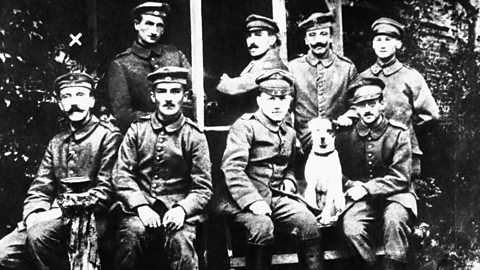
The beginnings of the Nazi Party
After the war, the army sent Hitler to Munich to spy on the German Workers’ Party, an emerging political group. Hitler attended some of their meetings and found he agreed with many of their ideas. In September 1919, he decided to join the group, which was led by Anton Drexler.
Hitler was a good public speaker, and helped the small political party to gain supporters. In 1920, the party was renamed the National Socialist German Workers Party, which became known as the Nazi Party. The main beliefs of the Nazi Party were antisemitism, racism, nationalismA feeling that people have of being proud of their country, often with the belief that it is better or more important than other countries., and strong hostility towards other political systems, including democracyA form of government in which people choose their leaders by voting., socialismA political system in which wealth and property are owned by the whole community, not by individuals or businesses. and communismA system of running a country in which all means of production such as tools, factories and raw materials, are owned by the community as a whole. Private property does not exist and each individual contributes according to their ability and receives according to their needs. This means there is no hierarchy of social class..
By 1921, Hitler had taken over the leadership of the party. They had a 25-point programme, containing ideas including:
- Destroying the Treaty of Versailles.
- Preventing Jewish people from being German citizens.
- Introducing new laws on immigrationComing to live permanently in a foreign country..
The Munich Putsch
By 1923, the Nazi Party was gaining support. Germany was struggling to recover from World War One and the harsh terms that the Treaty of Versailles had inflicted upon them. Hitler believed that if he started an uprising, known in German as a ‘Putsch’, people would join him and he would be able to overthrow the government.
On 8 November 1923, Hitler stormed into a beer hall in Munich where a political meeting was being held by the leader of BavariaA region in the south-east of Germany., Gustav Kahr. He had the support of German war hero General Ludendorff and persuaded Kahr to support his revolution. This uprising is known as the Munich Putsch, or Beer Hall Putsch.
On the morning of 9 November, Hitler marched through the streets of Berlin. The police had been tipped off and Hitler fled. He was arrested on 11 November. Hitler was sentenced to 5 years in Landsberg prison, but was released after just 9 months.
While in prison, Hitler wrote a book, Mein Kampf (My Struggle), in which he set out his ideas for the future of Germany, as well as many of his antisemitic ideas. This included his racist belief that Jews should be stripped of German citizenship, and the false idea that German people were part of a so-called 'Aryan race'An idea developed in the 1800s, believed by Hitler and the Nazis, that people from northern and western Europe were racially 'superior' to other groups. There is no scientific basis for this idea., and therefore superiorBeing better or of a higher quality. to so-called ‘inferior’ races, including Jewish people, RomaAn ethnic group originating in South Asia who migrated to Europe from the Middle Ages onwards. and SintiThe group of Roma people who lived in central and eastern Europe.. He wrongly alleged that Jewish businesses and banks hoarded wealth, forcing others to live in poverty. These ideas were largely ignored by the German electorateThe people in a country who are allowed to vote in an election. until the mass unemployment caused by the Great DepressionA global economic crisis that started in 1929 in the USA. It led to mass unemployment and hardship throughout the 1930s..
The changing fortunes of the Nazi party in Reichstag elections
Nazi Party electoral graph
Hitler becomes Chancellor
On Hitler’s release from prison, the Nazi Party struggled. They were unsuccessful in elections and their ideas were not appealing.
In 1929, the Great Depression caused a worldwide economic crash which gave Hitler an opportunity. There were 6 million people unemployed in Germany. Hitler took advantage of the economic problems and blamed them on Jewish people, who were a tiny minority - less than 1% of the German population. The Nazis also blamed the Treaty of Versailles and the actions of foreign countries. Nazi propagandaPutting forward biased information to persuade people to believe a particular point of view. posters claimed that Hitler would be able to find solutions to Germany’s economic problems. These ideas were popular and the Nazis started to win seats in the ReichstagThe German Parliament..
Hitler understood the importance of propaganda. He made lots of speeches and travelled round Germany to meet people, trying to show that he understood their problems.
Hitler also made use of the SturmabteilungA group within the Nazi Party, also known as Stormtroopers, who wore military uniforms and marched through the streets. They were very violent and often attacked political opponents, such as communists, in the street., better known as the SA, or the ‘Brownshirts’. They were also known as Stormtroopers. The SA had 2 million members by early 1933. Hitler used them to disrupt the meetings of political opponents, intimidate voters and promote Nazi ideas and policies. The Communist Party in particular was targeted by the SA. They were an electoral threat to the Nazis and Hitler hated their ideas and policies.
By the summer of 1932, the Nazis had become Germany’s most popular political party. In response, the German president, Paul von Hindenburg, decided to give Hitler the role of ChancellorThe leader in the Reichstag, appointed by the German President., though he didn’t like Hitler very much. Hindenburg wrongly believed that Hitler could be controlled, and that the German public would not tolerate his ideas after seeing him in power.
Hitler became Chancellor on 30 January 1933. This role was the second highest political position in Germany.
The Reichstag fire
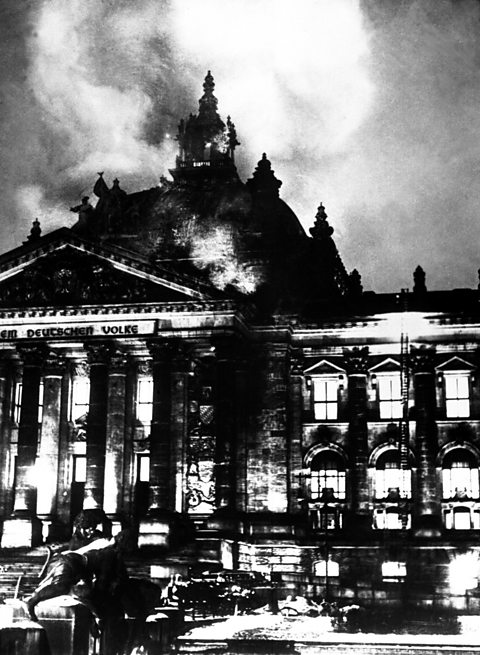
After being appointed as Chancellor, Hitler moved quickly to secure his power. In the role of Chancellor, Hitler was able to introduce new laws in the Reichstag. However, he still had President Hindenburg above him, who was head of state. Hitler wanted to be a dictatorA ruler with total power over a country, who has generally come into power through force. Dictators usually rule in a cruel and brutal way., and to be able to pass laws on his own without the need for a vote in the Reichstag.
On 27 February 1933, there was a fire in the Reichstag building. This was just four weeks after Hitler had been appointed Chancellor, and right before another election was due to take place. A Dutch communist named Marinus van der Lubbe was found inside. He confessed to starting the fire. However, exactly who started the fire is still debated by historians today.
Some historians believe the fire was a Nazi plot to justify action against communists and Jews. Van der Lubbe had mental health issues, and it has been argued that he would not have been able to act alone. In 1998, he was posthumouslyAfter someone has died. pardoned by a German court.

Chancellor to dictator
On 5 March 1933, Reichstag elections were held. Despite the Nazis’ attempts to blame communists for the Reichstag fire, they still did not win a majority. This meant Hitler would not be able to rule as he wanted, as new laws he proposed could be outvoted by other parties in the Reichstag.
On 23 March 1933, the Nazis passed the Enabling Act, giving Hitler the right to make laws on his own without a vote in the Reichstag. The vote needed two thirds of the Reichstag to vote in favour to change the constitution in this way. Hitler had Communist Party members of the Reichstag arrested, so they were unable to vote, and intimidated other opposition members to stop them voting against the law.
The law was passed by 444 votes to 94. The 81 Communist Party members of the Reichstag were not counted in the total, so Hitler achieved the two thirds that he needed. The passing of the Enabling Act meant there was no political opposition to stop Hitler passing any laws he wanted.
In August 1934, President Hindenburg died. Hitler combined the roles of Chancellor and President into one position, making himself Führer, or ‘leader’. This completed his move from Chancellor to dictator.
Activity - Put the events in order
Test your knowledge
The gave advice and guidance during the production of this guide.
Play the History Detectives game! gamePlay the History Detectives game!
Analyse and evaluate evidence to uncover some of history’s burning questions in this game.

More on World War Two and the Holocaust
Find out more by working through a topic
- count7 of 10
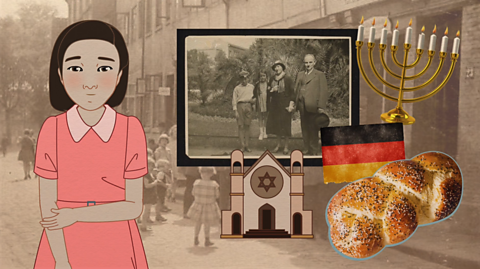
- count8 of 10

- count9 of 10
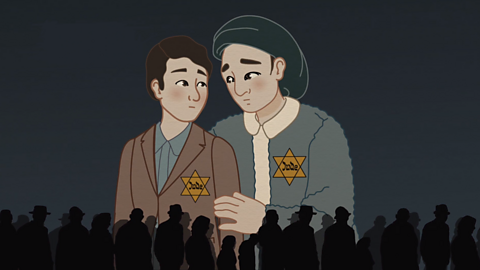
- count10 of 10
